#home textile exporter
Explore tagged Tumblr posts
Text
[T]he Dutch Republic, like its successor the Kingdom of the Netherlands, [...] throughout the early modern period had an advanced maritime [trading, exports] and (financial) service [banking, insurance] sector. Moreover, Dutch involvement in Atlantic slavery stretched over two and a half centuries. [...] Carefully estimating the scope of all the activities involved in moving, processing and retailing the goods derived from the forced labour performed by the enslaved in the Atlantic world [...] [shows] more clearly in what ways the gains from slavery percolated through the Dutch economy. [...] [This web] connected them [...] to the enslaved in Suriname and other Dutch colonies, as well as in non-Dutch colonies such as Saint Domingue [Haiti], which was one of the main suppliers of slave-produced goods to the Dutch economy until the enslaved revolted in 1791 and brought an end to the trade. [...] A significant part of the eighteenth-century Dutch elite was actively engaged in financing, insuring, organising and enabling the slave system, and drew much wealth from it. [...] [A] staggering 19% (expressed in value) of the Dutch Republic's trade in 1770 consisted of Atlantic slave-produced goods such as sugar, coffee, or indigo [...].
---
One point that deserves considerable emphasis is that [this slave-based Dutch wealth] [...] did not just depend on the increasing output of the Dutch Atlantic slave colonies. By 1770, the Dutch imported over fl.8 million worth of sugar and coffee from French ports. [...] [T]hese [...] routes successfully linked the Dutch trade sector to the massive expansion of slavery in Saint Domingue [the French colony of Haiti], which continued until the early 1790s when the revolution of the enslaved on the French part of that island ended slavery.
Before that time, Dutch sugar mills processed tens of millions of pounds of sugar from the French Caribbean, which were then exported over the Rhine and through the Sound to the German and Eastern European ‘slavery hinterlands’.
---
Coffee and indigo flowed through the Dutch Republic via the same trans-imperial routes, while the Dutch also imported tobacco produced by slaves in the British colonies, [and] gold and tobacco produced [by slaves] in Brazil [...]. The value of all the different components of slave-based trade combined amounted to a sum of fl.57.3 million, more than 23% of all the Dutch trade in 1770. [...] However, trade statistics alone cannot answer the question about the weight of this sector within the economy. [...] 1770 was a peak year for the issuing of new plantation loans [...] [T]he main processing industry that was fully based on slave-produced goods was the Holland-based sugar industry [...]. It has been estimated that in 1770 Amsterdam alone housed 110 refineries, out of a total of 150 refineries in the province of Holland. These processed approximately 50 million pounds of raw sugar per year, employing over 4,000 workers. [...] [I]n the four decades from 1738 to 1779, the slave-based contribution to GDP alone grew by fl.20.5 million, thus contributing almost 40% of all growth generated in the economy of Holland in this period. [...]
---
These [slave-based Dutch commodity] chains ran from [the plantation itself, through maritime trade, through commodity processing sites like sugar refineries, through export of these goods] [...] and from there to European metropoles and hinterlands that in the eighteenth century became mass consumers of slave-produced goods such as sugar and coffee. These chains tied the Dutch economy to slave-based production in Suriname and other Dutch colonies, but also to the plantation complexes of other European powers, most crucially the French in Saint Domingue, as the Dutch became major importers and processers of French coffee and sugar that they then redistributed to Northern and Central Europe. [...]
The explosive growth of production on slave plantations in the Dutch Guianas, combined with the international boom in coffee and sugar consumption, ensured that consistently high proportions (19% in 1770) of commodities entering and exiting Dutch harbors were produced on Atlantic slave plantations. [...] The Dutch economy profited from this Atlantic boom both as direct supplier of slave-produced goods [from slave plantations in the Dutch Guianas, from Dutch processing of sugar from slave plantations in French Haiti] and as intermediary [physically exporting sugar and coffee] between the Atlantic slave complexes of other European powers and the Northern and Central European hinterland.
---
Text above by: Pepijn Brandon and Ulbe Bosma. "Slavery and the Dutch economy, 1750-1800". Slavery & Abolition Volume 42 (2021), Issue 1. Published online 28 February 2021. DOI at: doi dot org slash 10.1080/01440396 . 2021. 1860464 [Text within brackets added by me for clarity and context. Bold emphasis and some paragraph breaks/contractions added by me. Presented here for commentary, teaching, criticism.]
#abolition#these authors lead by pointing out there is general lack of discussion on which metrics or data to use to demonstrate#extent of slaverys contribution to dutch metropolitan wealth when compared to extensive research#on how british slavery profits established infrastructure textiles banking and industrialisation at home domestically in england#so that rather than only considering direct blatant dutch slavery in guiana caribbean etc must also look at metropolitan business in europe#in this same issue another similar article looks at specifically dutch exporting of slave based coffee#and the previously unheralded importance of the dutch export businesses to establishing coffee mass consumption in europe#via shipment to germany#which ties the expansion of french haiti slavery to dutch businesses acting as intermediary by popularizing coffee in europe#which invokes the concept mentioned here as slavery hinterlands#and this just atlantic lets not forget dutch wealth from east india company and cinnamon and srilanka etc#and then in following decades the immense dutch wealth and power in java#tidalectics#caribbean#archipelagic thinking#carceral geography#ecologies#intimacies of four continents#indigenous#sacrifice zones#slavery hinterlands#european coffee#indigenous pedagogies#black methodologies
50 notes
·
View notes
Text
Top Bed Sheet Manufacturers And Wholesalers - Enrock Impex
Enrock Impex is the top bedsheet manufacturer, exporter, and wholesaler. Right from micro cotton bedsheets, plain hotel bedsheets, satin striped bedsheets, printed bedsheets, hospital bedsheets you name it and You get it from Enrock. Similarly, Enrock Impex can supply you with single bedsheets, double, king-size, and queen-size bedsheets as per your needs Check them out once
#Bed Sheet Manufacturers#Bed Sheets#home textiles exporters#home textiles suppliers#carpet manufacturers in india#home textiles manufacturer in india#enrock impex
0 notes
Text
Eco-Friendly Products Fair in 2024
In a world that is increasingly becoming aware of the environmental challenges it faces, the need for sustainable practices has never been more crucial.
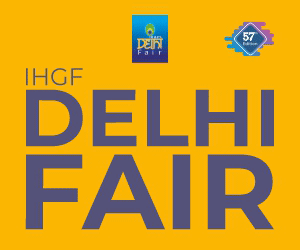
The year 2024 brings forth an inspiring event that echoes the spirit of eco-consciousness – the Eco-Friendly Handicraft Products Fair.
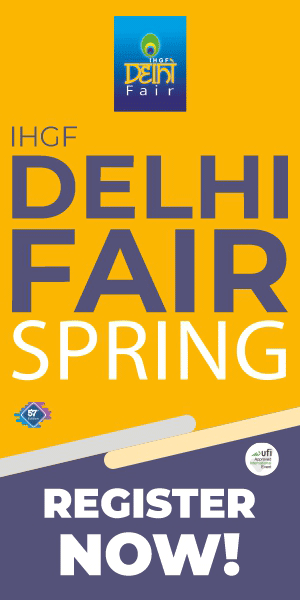
This fair is not just a congregation of artisans and craftsmen but a testament to the growing global movement towards sustainable living and responsible consumption. In this comprehensive exploration, we delve into the significance of such events, the impact they have on local economies, and how they contribute to a more sustainable and environmentally conscious future.
The Rise of Eco-Friendly Handicrafts
Handicrafts have been an integral part of human history, reflecting diverse cultures and traditions. However, as the world grapples with environmental issues, there is a growing shift towards eco-friendly alternatives in every aspect of life, including handicrafts. The use of sustainable materials, ethical production processes, and environmentally friendly packaging are becoming key considerations for both artisans and consumers.
This shift is not merely a trend but a paradigm shift in the way we approach craftsmanship and consumption. The Eco-Friendly Handicraft Products Fair of 2024 serves as a platform to showcase and celebrate the innovation and creativity of artisans who are committed to crafting products that leave a minimal ecological footprint.
The Impact of Eco-Friendly Handicrafts on Local Economies
One of the remarkable aspects of the Eco-Friendly Handicraft Products Fair is its positive impact on local economies. By promoting traditional craftsmanship that utilizes sustainable materials, the fair empowers local artisans, creating economic opportunities within communities. This not only preserves cultural heritage but also fosters a sense of pride and identity among craftsmen.
Moreover, the fair provides a unique avenue for small-scale artisans to access larger markets. Through networking and exposure gained at such events, these artisans can establish connections with retailers and consumers who are increasingly seeking sustainable products. This, in turn, contributes to the economic development of the regions where these artisans reside.
The fair acts as a catalyst for sustainable entrepreneurship, encouraging artisans to adopt eco-friendly practices not only for ethical reasons but also for economic viability. As consumers become more conscientious about their purchasing decisions, there is a growing demand for products that align with environmental values. The Eco-Friendly Handicraft Products Fair becomes a bridge connecting conscious consumers with artisans who share their commitment to sustainability.
Innovations in Eco-Friendly Handicrafts
The fair is not just a showcase; it is a breeding ground for innovation. Artisans from around the world come together to exchange ideas, techniques, and experiences in creating eco-friendly handicrafts. This cross-pollination of ideas leads to the emergence of new and innovative products that marry traditional craftsmanship with modern sustainability practices.
For example, artisans may experiment with upcycling – transforming discarded materials into high-quality handicrafts. This not only reduces waste but also adds a unique narrative to the products. Similarly, the use of renewable materials such as bamboo, organic cotton, and recycled metals is explored, highlighting the versatility and potential of sustainable resources.
In addition to materials, the fair also explores sustainable production processes. Artisans may adopt low-impact techniques, such as natural dyeing methods, energy-efficient manufacturing, and water conservation practices. These innovations not only reduce the environmental footprint of the products but also contribute to the overall sustainability of the handicraft industry.
Educational Initiatives and Workshops
A key aspect of the Eco-Friendly Handicraft Products Fair is its commitment to education and awareness. Workshops, seminars, and interactive sessions are organized to inform both artisans and consumers about the importance of eco-friendly practices. These initiatives aim to bridge the gap in understanding and provide practical insights into incorporating sustainability into the handicraft industry.
Artisans benefit from these workshops by gaining knowledge about the latest sustainable practices, certifications, and market trends. This empowers them to make informed decisions about their craft, ensuring that they remain competitive in an evolving market that values sustainability.
On the consumer side, educational initiatives raise awareness about the environmental impact of consumer choices. Understanding the journey of a product – from raw materials to finished handicraft – allows consumers to make more conscious decisions. By fostering a sense of responsibility, the fair contributes to the larger goal of creating a consumer base that values quality over quantity and sustainability over convenience.
Promoting Cultural Diversity
While the focus of the fair is on eco-friendly practices, it also serves as a celebration of cultural diversity. Traditional handicrafts are deeply rooted in the cultural heritage of communities around the world. The fair provides a stage for artisans to showcase their unique cultural expressions through their crafts.
From intricate handwoven textiles to delicately carved wooden artifacts, the fair is a kaleidoscope of cultural richness. This celebration not only preserves traditional art forms but also fosters cross-cultural appreciation. Visitors to the fair are exposed to a plethora of artistic traditions, creating a global tapestry of creativity that transcends borders.
Furthermore, the fair encourages collaborations between artisans from different cultural backgrounds. These collaborations often result in the fusion of diverse artistic styles, leading to the creation of hybrid handicrafts that carry the essence of multiple cultures. This cross-pollination not only produces aesthetically rich products but also fosters understanding and harmony among communities.
Addressing Environmental Challenges
In addition to showcasing eco-friendly products, the fair takes a proactive stance in addressing environmental challenges. Panel discussions, forums, and keynote addresses by experts in environmental sustainability provide a platform for dialogue and knowledge exchange.
Topics such as climate change, deforestation, and pollution are discussed in the context of the handicraft industry. This holistic approach aims to create awareness about the broader environmental issues that impact both artisans and consumers. By fostering a sense of responsibility, the fair encourages participants to consider the long-term environmental consequences of their choices and actions.
Moreover, the fair explores ways in which the handicraft industry can actively contribute to environmental conservation. This may involve initiatives such as tree planting campaigns, waste reduction programs, or collaborations with environmental organizations. By aligning the industry with environmental stewardship, the fair sets a precedent for other sectors to follow suit.
Networking Opportunities for Artisans
One of the invaluable aspects of the Eco-Friendly Handicraft Products Fair is the networking opportunities it provides for artisans. Traditionally, many artisans, especially those from remote or economically disadvantaged regions, face challenges in reaching wider markets. The fair serves as a bridge, connecting these artisans with retailers, distributors, and even fellow craftsmen.
The networking opportunities extend beyond the duration of the fair. Artisans often establish long-lasting connections that result in ongoing collaborations and partnerships. This not only benefits individual artisans but also contributes to the overall growth and sustainability of the handicraft industry.
Collaborations may take various forms, from joint ventures in production to co-hosting workshops and exhibitions. Such partnerships not only enhance the visibility of artisans but also facilitate the exchange of skills and knowledge. This collaborative spirit is a powerful driver for positive change within the handicraft community.
Consumer Empowerment and Conscious Choices
The fair is not just a marketplace; it is an arena for empowering consumers to make conscious choices. As consumers become increasingly aware of the environmental impact of their purchases, they seek products that align with their values. The fair provides a curated selection of eco-friendly handicrafts, allowing consumers to make informed decisions about the products they bring into their homes.
Through interactions with artisans and educational initiatives, consumers gain insights into the craftsmanship and the story behind each product. This transparency creates a sense of connection between the consumer and the artisan, fostering a deeper appreciation for the value of handmade, eco-friendly products.
Moreover, the fair encourages consumers to adopt a more mindful approach to consumption. By emphasizing the quality, durability, and timeless appeal of handicrafts, the fair challenges the prevailing culture of disposable and mass-produced goods. This shift towards conscious consumption not only benefits the environment but also contributes to the well-being of artisans who produce goods with care and dedication.
Conclusion
The Eco-Friendly Handicraft Products Fair of 2024 stands as a beacon of hope and inspiration in a world grappling with environmental challenges. It goes beyond being a mere exhibition; it is a movement that champions sustainability, celebrates cultural diversity, and empowers both artisans and consumers. The fair not only provides a platform for the showcase of eco-friendly handicrafts but also fosters a community of like-minded individuals committed to making a positive impact on the planet.
As the world continues to navigate the complex landscape of environmental issues, initiatives like the Eco-Friendly Handicraft Products Fair play a pivotal role in shaping a more sustainable and conscious future. Through collaboration, innovation, and education, this fair contributes to the ongoing global effort to create a world where craftsmanship and environmental stewardship coexist harmoniously.
#home textiles#handicrafts accessories#indian furnishings#indian trade fair#gifts show#ihgf delhi fair#handicrafts#fashion accessories#handicraft fair#crafts#handicrafts exporters#handicrafts exhibition#indian handicrafts exporters#exhibition#export#cane bamboo & eco friendly products#ecofriendly#sustainability#environmental#environment#materials#environmentalism#ecology#ecosystem#home furniture#handmade#home decor#handicraft
0 notes
Text
Unveiling Global Market Dynamics: Harnessing Export-Import Data for Home Textiles

Introduction
The home textiles industry is a dynamic and global sector that encompasses a wide range of products, including bedding, towels, curtains, and more. Understanding market dynamics, trends, and opportunities is essential for businesses operating in this space. One invaluable tool for gaining insights into the home textiles market is export-import data. In this article, we will explore how harnessing export-import data can unveil global market dynamics and provide a competitive edge to home textiles businesses.
The Global Home Textiles Landscape
The home textiles industry has witnessed significant growth over the years, driven by factors such as urbanization, rising disposable incomes, and changing consumer lifestyles. However, the industry is not immune to market fluctuations and shifts in consumer preferences. To thrive in this environment, businesses need to stay informed about the global market dynamics that impact their operations.
Why Export-Import Data Matters
Export-import data offers a wealth of information about the home textiles industry. It includes details about the volume, value, origin, and destination of products being traded internationally. Here's why export-import data matters:
Read more:
0 notes
Text
Finest Home Textile Manufacturers in India - Quality Craftsmanship & Elegance Discover a world of luxurious home textiles crafted with precision and elegance by India's finest manufacturers. From exquisite bedding sets and cozy blankets to plush towels and decorative cushions, our collection showcases the epitome of comfort and style. Experience the artistry of Indian textile manufacturers, blending traditional techniques with modern innovation to transform your home into a haven of sophistication.
Visit: https://www.abhihome.in/
0 notes
Text

Introducing a new birg culture, and the reason the Twowi go to such lengths to cross the icy equator with their cargoes of rare metal and pungent gall-spice. The Ss’wassoum are a wealthy empire based on the far southern coast, where the sea-ice melts more quickly in the spring and its people first built their wealth on the sea-harvest. Their language is heavy on harmonized syllables, which lends their speech a distinctive musical quality. Family units are smaller than the fiercely clannish Twowi, and the gender divide is less rigid, though still distinctly matriarchal. Some of their most lucrative raw exports are refined tree-plastics and sea-silk, which is valued for fine textiles.
While the Twowi run on highly specialized industrial clan-towns, the Ss’wassoum exist in more diverse cities, though the class divide is impossible to ignore. The nobility are loud of dress and voice, with their ornate refined plastic head-dresses, vividly patterned veils, and resonators worn over the rear spiracles to enhance their voices. But despite all the attention they draw to themselves, their faces are always covered; to be perceived as gray-furred mortals akin to any commoner is inconceivable. They walk the streets as living demigods. Just below the nobility are the merchant class, which may approach their influence in wealth and education but are legally barred from the elaborate headwear and home exteriors of their superiors. Instead they adorn the insides of their homes with the latest in art and technology, particularly elaborate electric light fixtures crafted from imported Twowi metal. Commoners wear little at all in the sunny months, save for the occasional beaded sash and brass mandible-cuffs. Sailors and other hard laborers frequently adorn their bodies with scarified and dyed patterns to mark themselves for the goodwill of protective gods.
The Ss’wassoum government does implement a standardized education system of sorts, though only those of the upper class can test or pay their way into the finest schools, where they can master the high dialect and the art of Opinion. Historically, etiquette laws forbade the discussion of controversial topics in public spaces; these were reserved for halls of judgement. The rule is more of a social taboo these days, but an ancient loophole ruled that written forms of debate could be presented anywhere, and with the subsequent invention of movable type, a colorful written debate culture flourished. Wherever there is a public bulletin, a cafe wall, a blank space where people gather, you fill find posted essays on anything from the hypocrisy of the noble class to a long winded treatise on the merits of toe-biter clams. It is not uncommon for a debate topic to outlive the original essayists, as hills are chosen to literally die on are then proudly upheld by the writer’s descendants. So ingrained into Ss’wassoum society is this debate culture, that committed debate rivals may be legally recognized as a marriage-like partnership. Though the Ss’wassoum carry no expectations of monogamy to a reproductive partner, the correlation between rivalry and mating season partners does not go unnoticed. As a general rule, a worldly and strongly opinionated individual is more attractive.
Big thanks to @primalmuckygoop for pitching so many great ideas for these guys, including most of the lore on their debate culture, and the very name of this civilization!
—————
If you’d like to see more stuff in the works for birgworld, check out my Patreon!
Or you can support me through Kofi and Inprnt
1K notes
·
View notes
Text
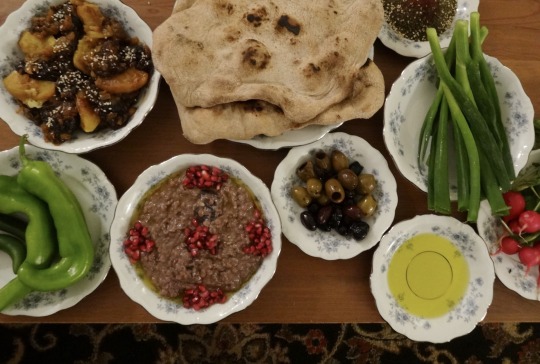
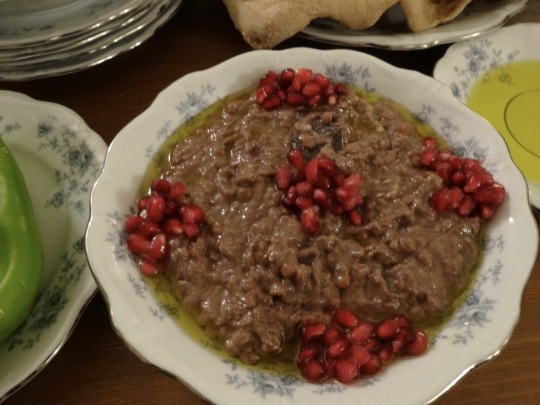
[ID: A purplish-grey stew topped with olive oil and garnished with piles of pomegranate seeds. Plates of green peppers, bitter olives, olive oil, taboon bread, green onions, radishes, and za'tar surround the dish. The second image is a close-up of the same stew. End ID]
رمانية / Rummāniyya (Palestinian pomegranate stew)
Rummaniyya (رُمَّانِيَّة; also transliterated "rumaniyya," "rummaniya," and "rummaniyeh") is a Palestinian stew or dip made from lentils, eggplant, and pomegranate seeds, flavored with nutty red tahina and a zesty, spicy دُقَّة (dugga) of dill seeds, garlic, and peppers. A طشة (ṭsha), or tempering, of olive oil and onion or garlic is sometimes added.
"Rummaniyya," roughly "pomegranate-y," comes from رُمَّان ("rummān") "pomegranate," plus the abstract noun suffix ـِيَّة ("iyya"); the dish is also known as حبّة رُمَّانَة ("ḥabbat rommāna"), or "pomegranate seeds." It is a seasonal dish that is made at the end of summer and the beginning of fall, when pomegranates are still green, unripe, and sour.
This stew is considered to be one of the most iconic, historic, and beloved of Palestinian dishes by people from Gaza, Yaffa, and Al-Ludd. Pomegranates—their seeds, their juice, and a thick syrup made from reducing the juice down—are integral to Palestinian cuisine and heritage, and images of them abound on ceramics and textiles. Pomegranates and their juice are sold from street carts and cafes in the West Bank and Gaza.
Today, tens of thousands of tons of pomegranates are grown and harvested by Israeli farmers on stolen Palestinian farmland; about half of the crop is exported, mainly to Europe. Meanwhile, Palestinians have a far easier time gaining permits to work on Israeli-owned farms than getting permission from the military to work land that is ostensibly theirs. These restrictions apply within several kilometers of Israel's claimed borders with Gaza and the West Bank, some of the most fertile land in the area; Palestinian farmers working in this zone risk being injured or killed by military fire.
Israel further restricts Palestinians' ability to work their farms and export crops by imposing tariffs, unexpectedly closing borders, shutting down and contaminating water supplies, spraying Palestinian crops with pesticides, bulldozing crops (including eggplant) when they are ready to be harvested, and bombing Palestinian farmland and generators. Though Palestinian goods have local markets, the sale of Palestinian crops to Israel was forbidden from 2007 to 2014 (when Israel accepted shipments of goods including tomato and eggplant).
Gazans have resisted these methods by disregarding orders to avoid the arable land near Israel's claimed borders, continuing to forage native plants, growing new spices and herbs for export, planting hydroponic rooftop gardens, crushing chalk and dried eggplants to produce calcium for plants, using fish excrement as fertilizer, creating water purification systems, and growing plants in saltwater. Resisting Israeli targeting of Palestinian food self-sufficiency has been necessary for practical and economic reasons, but also symbolizes the endurance of Palestinian culture, history, and identity.
Support Palestinian resistance by calling Elbit System's (Israel's primary weapons manufacturer) landlord; donating to Palestine Action's bail fund; and buying an e-Sim for distribution in Gaza.
Serves 6-8.
Ingredients:
For the stew:
1 medium eggplant (370g)
1 cup brown lentils (عدس اسود)
600g pomegranate seeds (to make 3 cups juice)
3 Tbsp all-purpose flour
1/4 cup red tahina
1/2 cup olive oil
Salt, to taste
Citric acid (ملح الليمون / حامِض ليمون) (optional)
Red tahina may be approximated with home cooking tools with the above-linked recipe; you may also toast white tahina in a skillet with a little olive oil, stirring often, until it becomes deeply golden brown.
For the دُقَّة (dugga / crushed condiment):
2 tsp cumin seeds, or ground cumin
1 1/2 Tbsp dill seeds ("locust eye" بذور الشبت / عين جرادة)
5 cloves garlic
1 green sweet pepper (فلفل بارد اخضر)
2 dried red chilis (فلفل شطة احمر)
People use red and green sweet and chili peppers in whatever combination they have on hand for this recipe; e.g. red and green chilis, just green chilis, just red chilis, or just green sweet peppers. Green sweet peppers and red chilis are the most common combination.
For the طشة (Tsha / tempering) (optional):
Olive oil
1 Tbsp minced garlic
Instructions:
1. Rinse and pick over lentils. In a large pot, simmer lentils, covered, in enough water to cover for about 8 minutes, or until half-tender.
2. Meanwhile, make the dugga by combining all ingredients in a mortar and pestle or food processor, and grinding until a coarse mixture forms.
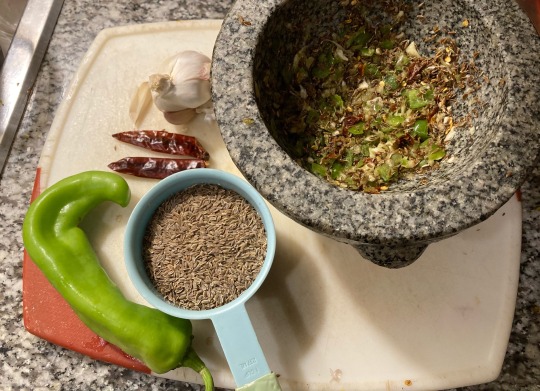
Dugga and components.
3. Cube eggplant. A medium-sized eggplant may be cut in half lengthwise (through the root), each half cut into thirds lengthwise, then cubed widthwise.
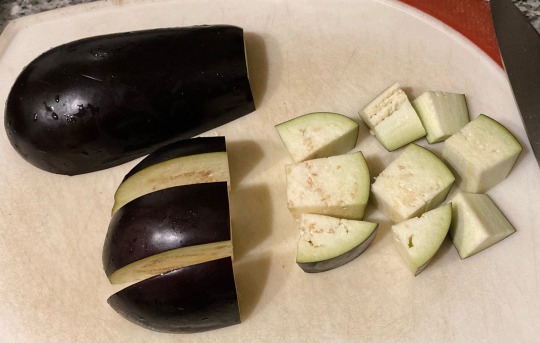
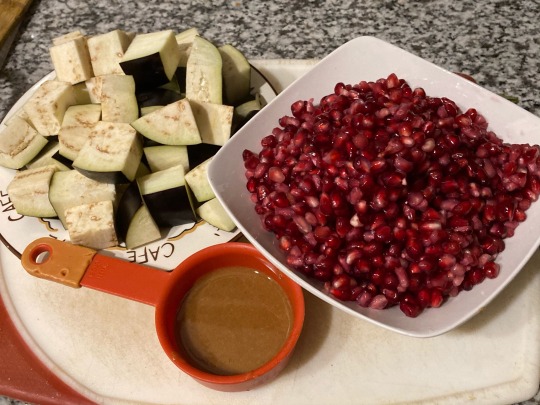
Cubed eggplant, red tahina, and pomegranate seeds.
4. Add eggplant to simmering water (there is no need to stir).
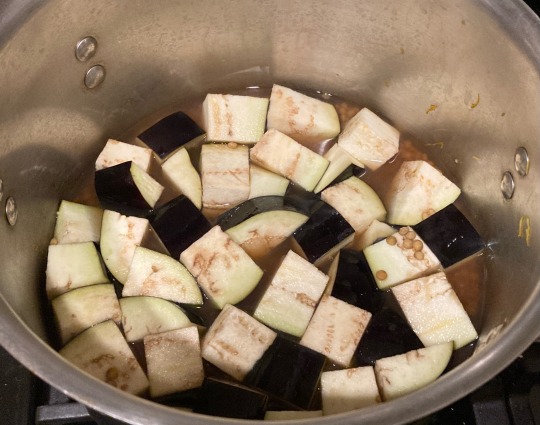
5. While the eggplant cooks, blend pomegranate seeds in a blender very thoroughly. Strain to remove any gritty residue. Whisk flour into pomegranate juice.
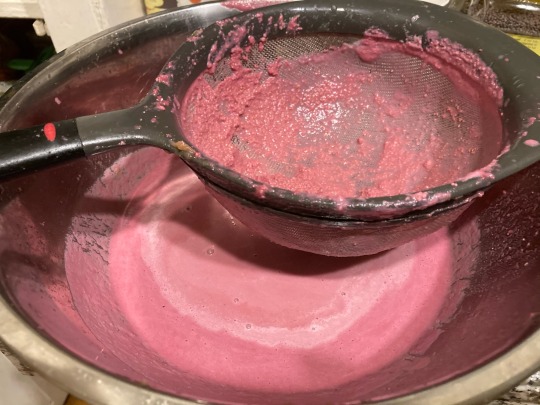
Pomegranate juice being strained.
6. Taste your pomegranate juice. If it is not sour, add a pinch of citric acid or a splash of lemon juice and stir.
7. Add dagga to the pot with the lentils and eggplant and stir. Continue to simmer until the eggplant is very tender and falling apart.
8. Add pomegranate juice, tahina, and olive oil to the pot, and simmer for another 5 minutes, or until stew is very thick and homogenous.
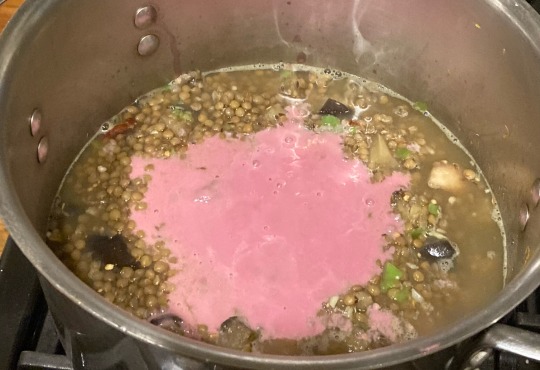
Bright pink pomegranate juice in stockpot.
9. (Optional) In a small skillet, heat a little olive oil on medium. Fry minced garlic, stirring constantly, until golden brown. Add into the pot and stir.
10. (Optional) Mash the stew with the bowl of a ladle or a bean masher to produce a more homogenous texture.
Serve rummaniyya hot or cold in individual serving bowls. It may be served as an appetizer, or as a main dish alongside flatbread, olives, and fresh vegetables such as radishes, green peppers, green onions, carrots, and romaine lettuce. It may be eaten with a spoon, or by using كماج (kmāj), a flatbread with an internal pocket, to scoop up each bite.
574 notes
·
View notes
Text
Self Development and Astrology( Vedic Astrology).
There are four main important houses in Astrology called as "Kendra house" ie one, four, seven and ten.
Rest all other houses are supporting houses.
First 🏠 house, is the house of self and personality. Sun is exalted in first house, because Sun is soul, so if you know your weakness and strength and work on your body regularly ( as Mars has lordship of first house) then no outside enemy can defeat you. And if your body is in good state then you can enjoy all the pleasures of the world..
Fourth house The most important house, once you get defeated emotionaly then nothing can help you, it is said, once, you loose emotionally you loose everything in life
So never depend Emotionally on anyone. Never give control of your emotional body to any one.
Jupiter is exalted in fourth house, because even if you loose everything in life but hold on to your morality, you will get everything in life again.
For native who has their Jupiter in two, six, four and ten it is better if you go in work related to Jupiter like counselling, and teaching, spirituality, and work related to religion.
Next house which is important is seventh House, is house of your focus and attention .
This house tells you, where you give your focus that area will expand, also tells you focus on your partnership or network, because your network is your networth, you finally become like the person with whom you spend most time with
Next house is your house of Karma, or the tenth house If you know what work makes you happy or you do what you enjoy,then you are the most carefree and happy person.
Tenth house is opposite to fourth house, it means, once you work hard, fourth house related things like luxury and comfort will come to you easily.
If you have Mercury in 10th house or fourth house, then would get success when you involve in communication, speech or develop some kind of skill
If you have Venus in fourth or tenth then it is better you do work related to cosmetics, luxury, apparels, textile.
If you have SUN in fourth or tenth then it is better you work alone and independent. You can be good politician as well
If you have Moon in fourth or in tenth then you can get involved in food related job, or in psychology or get in job which has traveling..
Mars in second or in tenth house, then involve in land, property, house, real estate, or in Army, police or in sports. Such natives have so much of energy when someone assigns them task they will finish it fast.
Saturn eighth or in tenth house, should take work as their service,they can go in politics, or in service related industry, here Saturn will give you success slowly with time .
If your tenth lord is in first house, then do work related to self improvement and your body, such natives are great and can achieve alot in their career on their own.
Tenth lord second house, do work with your family, or related to speech and cooking.
Tenth lord in third house, do work related to skill development, sports, with siblings, media, communication, commission.
Tenth lord in fourth are extremely good, because person would get all luxurious and comfort by his work. You can work for masses, also home related job or service.
Tenth lord in fifth is also good, you can go in teaching and learning.
Tenth lord in sixth, you can work in charity, for pets, as doctors, healers, health workers, as auditor.
Tenth lord in seventh, it is better to go for business.
Tenth lord in eighth, research, soy, insurance, Bank, occult, astrology.
Tenth lord in ninth, good, you can go in counselling, teaching spirituality, religious work
Tenth lord in tenth is good, you are hard working and can work in any job.
Tenth lord in eleventh, you can work as free Lancer, create multiple source of income, work in social media
Tenth lord in twelfth, you can work in foreign country, or in foreign company, MNCs, import export, hospital, yoga, meditation.
One, four, Sven and ten are actual spine of your chart and you need to constantly work in these houses, rest all houses are by product.

257 notes
·
View notes
Text

THURSDAY HERO: Johan Weidner
Johan “Jean” Weidner was a Dutch businessman who created an extensive underground rescue network and saved the lives of 800 Jews and 112 downed Allied aviators.
Born in Brussels in 1912 to Dutch parents, Jean grew up in Switzerland in a devout Seventh-Day Adventist home. His father, a minister who taught Greek and Latin at a church seminary, wanted Jean to become a clergyman but instead he decided to go into business. He moved to Paris in 1935 and started an import-export textile firm.
When the Germans occupied Paris in 1940 Jean dropped everything and fled to Lyon in unoccupied France. He had to abandon his company, so he started a new one in Lyon.
In 1941, as the situation for Jews and other enemies of the Nazi war machine grew more dire, Jean took action. He created an underground network secretly run out of his textile factory. To facilitate escape to Switzerland, Jean opened a second branch of his business in Annecy, near the Swiss border. The route was dotted with safe houses and locals sympathetic to the Resistance who sheltered the refugees and helped them cross the border.
Known as Dutch-Paris, the network Jean created became one of the most effective resistance groups during war. Also called “the Swiss Way,” the network’s mission was to rescue people targeted by the Nazis by hiding them until they could help them escape to a neutral country.
Jean was leader of 330 men, women and teenagers working clandestinely in occupied countries of Western Europe as well as in Switzerland.
Dutch-Paris was constantly in need of funds to support their extensive activities, and Jean made a deal with the Dutch ambassador to Switzerland. The Dutch government-in-exile in London would fund the rescue operations if Jean 1) expanded the escape route to reach all the way to Spain and 2) used the route to convey intelligence on microfilm between Dutch resistance groups. Jean agreed to the terms and the expanded network began operating in November 1943.
In January of 1944 they began rescuing downed Allied aviators, an especially dangerous operation because it attracted the attention of German military intelligence officers. In only a month they saved over 112 pilots before tragedy struck. In February 1944, a young Dutch woman working as a courier was arrested by the French police and turned over to the Gestapo. They tortured her physically and psychologically, and threatened her family. She cracked under pressure and gave up names of her colleagues colleagues in the Dutch-Paris network.
Germans started arresting members of Dutch-Paris, including Jean’s sister Gabrielle. Over the next few months, many of the rescuers were sent to concentration camps, where at least forty of them were murdered. Gabrielle survived until liberation by the Russians, but she was so malnourished that she died days later.
Jean was able to escape capture long enough to rebuild networks and continue his rescue operations. In Toulouse he was arrested by the French police, but he escaped before they were able to transfer him to the Germans.
France was liberated in November 1944 and Jean was invited to London by Queen Wilhemina to inform her about the Dutch-Paris route, and the situation for Dutch civilians in areas occupied by the Germans. He was made a Captian in the Dutch Armed Forces but after the war he was let go by the Dutch government for not being a professional policeman. Jean returned to his textile business, and in 1955 emigrated to the United States where he and his wife operated a chain of health food stores for several decades.
He received multiple awards for his wartime heroism including the US Medal of Freedom, the Croix de Guerre and the Legion d’honneur. He was honored as Righteous Among the Nations by Israeli Holocaust Memorial Yad Vashem, and a grove of trees was planted in his name. In 1993, at the opening of the United States Holocaust Museum in Washington DC, he was one of seven people chosen to light candles honoring rescuers.
Jean Weidner died in 1994 in Southern California. Abraham Foxman, then National Director of the ADL said, “John Weidner lived his entire life giving back… Until his death, he lived a life of selflessness and service, working tirelessly to make the world a better place.”
For creating an underground escape route for victims of the Nazis, and saving hundreds of lives, we honor Jean Weidner as this week’s Thursday Hero.
57 notes
·
View notes
Text
When you do not know a thing about the issue at stake...
...perhaps it's better to remain silent.
Some of you know, others don't - and that's fine - but my main field of expertise is labor law.
I just read this in anger and disbelief:
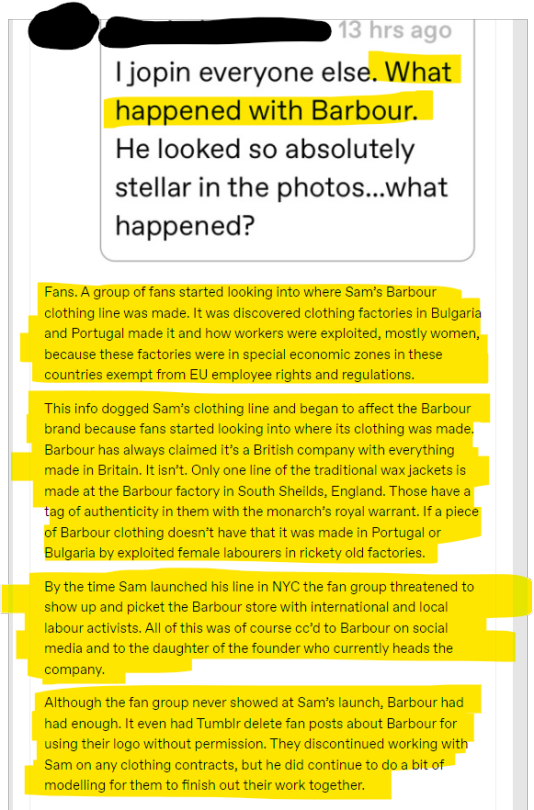
Look, lady. I don't care who the hell you are, what you do for a living or why you felt entitled to answer those insistent questions on your side of the fandom. I suppose you are North American and have no idea of how things work on this side of the pond. It is fine: I might know what a Congress filibuster is, for example, but I'd be severely unable to judge the finer points of competence sharing between Fed and state level.
The difference between you and me?
I keep my mouth shut and/or do my own research before opening it in public.
Have you no shame to write things like: 'It was discovered clothing factories in Bulgaria and Portugal made it and how workers were exploited, mostly women, because these factories were in special economic zones in these countries exempt from EU employee rights and regulations.'
HOW DARE YOU? What strange form of illiterate entitlement possessed you to utter such things with confidence, comfortably hidden behind a passive voice ('it was discovered')?
Portugal joined the EU in 1986. Bulgaria (and my country) joined the EU in 2007. I have given 5 relentless years of my life to make this collective political project a reality, along with hundreds of other people my age who chose to come back home from the West and put their skills to good use for their country. In doing so, I rejected more than 10 excellent corporate job offers in France and China. To see you come along and write such enormities is like having you spit in my face.
Article 4 of the Treaty on the Functioning of the European Union (aka The Treaty of Rome) is formal and clear, as far as competence sharing between the EU and its Member States goes (the UK was still, back then, a full member of the EU - it quit on February 1st 2020):

That means that ALL the EU regulations are being integrated into the national legislation of the Member States. This is not a copy/paste process, however. And because it is a shared competence area, the Member States have a larger margin of appreciation into making the EU rules a part of their own. While exceptions or delays in this process can be and are negotiated, the core principles are NEVER touched.
Read it one hundred times, madam, maybe you'll learn something today:
THERE ARE NO SPECIAL ECONOMIC ZONES IN THE EUROPEAN UNION. THE WHOLE FUCKING EUROPEAN UNION IS A SPECIAL ECONOMIC ZONE, THIS IS WHY IT IS CALLED THE SINGLE MARKET.
What the fuck do you think we are, Guangzhou? We'd wish, seeing the growth statistics!
Now, for the textile industry sector and particularly with regard to the Bulgarian market, a case very similar to my own country. Starting around 1965, many big European textile players realized the competitive advantage of using the lower paid, readily available Eastern European workforce. In order to be able to do business with all those dour Communist regimes, the solution was simple and easy to find: toll manufacturing.
It worked (and still does!) like this:
The foreign partner brings its own designs, textiles and know-how into the mix - or more simply put, it outsources all these activities. The locals transform it into the finished product, using their own workforce. The result is then re-exported to the foreign partner, who labels it and sells it. In doing so, he has the legal obligation to include provenance on the label ('made in Romania', 'made in Indonesia', 'made in Bulgaria' - you name it).
The reason you might find less and less of those 'made in ' labels nowadays at Primark and more and more at Barbour, Moncler and the such is the constant raise of the workers' wages in Eastern Europe since 1990 (things happened there, in 1989, maybe you remember?). We are not competitive anymore for midrange prêt-à-porter - China (Shein, anyone?), Cambodia and Mexico do come to mind as better suppliers. To speak about 'exploited female labourers in rickety old factories' is an insult and a lie. They weren't exploited back in the Eighties, as they are not now (workers in those factories were and still are easily paid about 50% more than all the rest) and the factories being modernized and constantly updated was always a mandatory clause in any contract of the sort. Normal people in our countries rarely or ever saw those clothes. You had to either be lucky enough for a semi-confidential store release or bribe someone working there and willing to take the risk, in order to be able to buy the rejected models on the local market.
If I understood correctly, you place this critical episode at the launch of the limited SRH & Barbour collection, for the fall of 2018. How convenient for you, who (I am told by trusted people) were one of the most vocal critics of S during Hawaii 2.0!
And as far as Barbour goes, it never pretended to manufacture everything in the UK only:

This information is absolutely true. You can read the whole statement, signed in October 2017 by one of their Directors, Ian Sime, here: https://www.barbour.com/us/media/wysiwyg/PDF/Ethical_Statement_October_2017.pdf
And a snapshot for you:
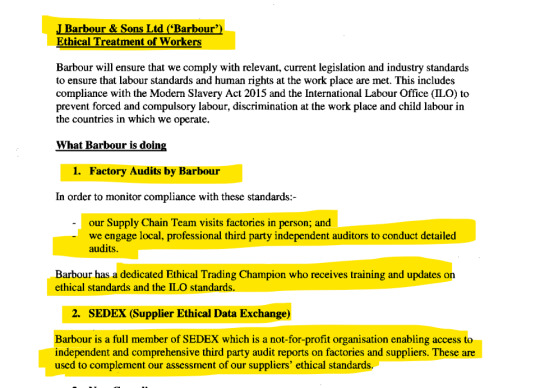
Oh, and: SEDEX is a behemoth in its world, with more than 75.000 companies joining as a member (https://www.sedex.com/become-a-member/meet-our-customers/). Big corporations like TESCO, Dupont, Nestle, Sainsbury's or Unilever included.
I am not Bulgarian, but I know all of this way better than you'll probably ever do. The same type of contracts were common all over Eastern Europe: Romania, Poland, the GDR (that's East Berlin and co, for you) and even the Soviet Union. I am also sure your Portuguese readers will be thrilled to see themselves qualified by a patronizing North American as labor exploiters living in a third-world country with rickety factories.
You people have no shame and never did. But you just proved with trooping colors you also have no culture and no integrity. More reasons to not regret my unapologetic fandom choice.
I expect an angry and very, very vulgar answer to this, even if I chose to not include your name/handle. The stench of your irrelevance crossed an ocean.
126 notes
·
View notes
Text
The 13th Annniversary Arshi Fiesta
Moodboard : historical AU
Whispers of the Heart | Chapter 02

I am not very good at writing ffs. I even read ffs very selectively. But it was an attempt of me to participate in the 13th-anniversary arshi fiesta. I might be wrong about certain aspects of that age and era, but it's a fantasy, so why not?
I don't own Arnav and Khushi and the story is purely fictional and has no relation to any living or dead. Any resemblance to actual persons, living or dead, or actual events is purely coincidental.



Chapter 2
After 10 years
Arnav was threading the busy traffic of the Bazar with his ambassador mark 1 to reach the St.Stephen all-women college of Delhi to pick up certain someone who he hadn't talked to, for almost 2 years. Though it was the cheapest car of that generation, it was his most prized possession at that moment, brought by the profit he got from his first export shipments of the textile factory he bought 1 year ago. But his mind was on that girl who lived in his mind rent-free till that fateful day 2 years ago and hadn't left ever since. Even at that moment, he could still feel her, if he closed his eyes.
Shaking himself off to get rid of that feeling, he concentrated on the road. Arnav's focus cleared to zoom in on that girl of question, no no, a young woman, in a simple white saree with a blue border, a mandatory college ware. The way she drapped the saree over her was very modest, but modesty seemed to allude Arnav today. His heart gave a thud realizing he could vividly feel how that petite body felt pressed to his. 'control yourself, Arnav. you've done so much damage already', Arnav chastised himself, willing his heart to a normal rhythm. Her jet-black hair was pleated into a single braid and a simple black bindi in the middle of her eyebrows that brought out her hazel-coloured doe eyes even more highlighted by a thin line of kajal. That was what Arnav was so scared of. Her little bindi had the power over him that the whole Oxford female fraternity didn't. He might have not talked to her but he saw her secretly every time he came to Dehli and watched her spread her wings like a butterfly to be the beautiful woman she ended up being. Roma Chachi had given her an apt name 'titliya'. All those times watching her from a distance Arnav tried his best to control his heart and mind, but ended up failing every single time. There was a reason why he avoided her for 2 years.
Khushi was standing at the gate of the college with her classmate, Sarita Chauhan, waiting for Akash Vai to pick her up. Khushi was irritated, she insisted on taking the rickshaw back home but due to the overprotective nature of Bhai and Babuji, she couldn't do that. But she didn't expect to see Him that day and somehow she knew he had come to pick her up. The last two years did a kind of magic to him or was it London or the girls of London to be exact, she didn't know. The Arnav sitting in front of her in that car donning the black glasses and clad in a rolled-up white shirt and black suspenders was a far cry from the man she last saw. But he was still Arnav among all of these, Her Arnav. That's why it didn't surprise her when her heart went overboard 'dhak-dhak,dhak-dhak,dhak-dhak'. Her friend beside her produced a small sound of appreciation,
"oh Khushi, you've never introduced me to your brothers. now I understand why." giving her a little nudge with her shoulder.
Khushi scoffed at her comment " he is not my brother. "
It's been 10 years since she lost her parents. And in the middle of all of these when Mahindar Chachu became her Babuji and Manoroma Chachi became Amma, she couldn't exactly pinpoint. And as a result, she got two brothers who loved her fiercely as their own. Abba had arranged a home tutor for her when she was 10 years old, because she couldn't bear the stress of public schooling. As soon as she started to form complete sentences her tutor advised her to write letters to her brothers, studying in Darjeeling. She wrote letters to Akash bhai and Aman bhai and then she wrote another letter to Arnav addressing him as 'Dear Arnav'. Her tutor chastised her for not adding a 'bhai' or a 'ji' at the end of his name. But Arnav was never her 'bhai', was he? He never felt like a 'bhai'. He was so much more. But above all, he was Her 'Arnav'.Just 'Arnav.' she used to call her 'Arnav' since she was 8. Nobody corrected her till she was 16. Then she started to call him 'Arnavji'. Now she didn't know what to call him anymore.
Arnav parked the car in front of her. when she made no move to sit inside, he took off the glasses unleashing his dark brown eyes on her. he opened the car door from inside and addressed her -
" what are you waiting for Khushi Kumari Gupta? Pandit bulake mahurat nikal na parega kya?" giving her the crooked half-smile that she adored. His familiar husky voice sent a wave of wistfulness through her. A thousand memories spun in her head, tangling together. God, she missed him so much. "Akash bhai and Aman are busy in the printing press. Cachu asked me to drop you home."
Khushi stared at him for another moment then with a huff she entered the car, which was a bad decision she understood not long after. Being in a closed space with him was torture. His enchanting woody scent engulfed her and transported her to a particular day that was in the centre of conflict between them. Both of them stared at anything but at each other, but soon Khushi couldn't resist the temptation to steal a look at him, which was a far worse decision than the previous one. Her eyes found his hands on the steering wheel, clutching it and as soon as a flashback of those hands flooded her mind - those hands clutching her smaller ones when they used to take a walk, those hands closing the hook of a payal around her ankles, those hands teaching her smaller ones to hold the chalk to write on the black slate, those hands helping her to plant rose plants on the garden. Her mind shifted to her smaller hands giving prasad to his larger ones, his hands cracking open the peanut shell for her whenever they went to the mela, his hands pulling her braids.'Have those hands become larger till the last time she saw them?' Khushi mused silently. Then a switch flipped in her mind, more flashbacks, she started to feel his hands on her cheek, on her waist, on the back of her head. Khushi closed her eyes tightly and clutched the books in her hands and to drive away those visions from her mind, blurted out what came to her mind at that moment " Anjali di said, you could not come to Delhi for another 3 months"
Arnav, looking at Khushi from the corner of his eyes, said "I didn't plan to. But My best friend is marrying my little sister. I wouldn't miss that wedding for the world and Roma Chachi said no more auspicious 'mohurat' after this month until the end of this year. And it's not like I have not been travelling to and fro between Delhi and London in the last couple of years."
Khushi nodding and trying to swallow down the hurt, said solemnly "I know."
Arnav had been studying law at Oxford University for the last couple of years. He had passed his bar exam and had been doing an apprenticeship under a Barrister in London for the last year. She knew all of this from Aman bhai. On the other hand, Arnav sold the land that his grandfather gave him and bought a run-down textile factory in old Delhi. She knew he had been very busy and she also knew he had been to Dehli multiple times in the last 2 years. He didn't stay in Rajput haveli nowadays when he came to Delhi. He had rented a two-storied bungalow on the outskirts of the town. But what hurt her more was he went to Rajput haveli to meet Amma and Babuji every time he came to Delhi, only when she was in school. So, it was not so difficult to figure out, who he was avoiding. Why, why she have to ruin the most important friendship she had in her life??? If only she wouldn't have done what she did 2 years ago.
It didn't escape Arnav's eyes the pain that flashed through her face. He still could read her like an open book, could decode the emotions that transpired through her pretty eyes. He regretted hurting her so much, but it was for the greater good. Sometimes he thought he preferred to remember her as still eight years old because she'd adored him then. She would gladly follow him anywhere. In fact, whenever she saw him leave, heading toward the garden where he liked to walk and think, she would come running after him. Even though she frequently fell, her little legs no match for his long, strong ones, she never cried and never complained. She was strong even back then.
Little Khushi used to fill their conversation with a million inquisitive questions though, looking at him with trusting big eyes. Her questions made him laugh and stumbled over answers.
When she was eight, he was her Hero.
As soon as the car reached Rajput Haveli, she all but sprinted away from him. Arnav sighed grabbing the package from the backseat he also entered the house. As soon as he reached the living room, he was met with Madhumati ji scolding Khushi for running around carelessly, even at the age of eighteen and her praying to God to give her 'sanka devi' same 'satbuddhi'. Then there was Roma Chachi, who came rushing towards him to give him a hug. Roma Chachi never failed to make him feel loved. Arnav admired this woman for her enormous capacity to love those who weren't hers.
"London suits you, Arnav Bitwa, look at you, how handsome you've turned out to be!!!! "
Arnav's tall figure folded itself to return her hug, teasing her he proceeded "And you didn't change at all Roma chachi. Still as gorgeous as ever. I missed you so much."
Manoroma smiled at him fondly. A child she once wished was hers so that she could have protected him from the heartbreak he endured at such a tender age " I missed you too, Bitwa. Don't be a stranger now like you have been for past years, ab toh hum ristedaar bhi banne wale hain."
Arnav smilled at her " I'll try."
Manoroma continued, "I hope you are staying with us this time, aren't you?" seeing Arnav nodding his head, she continued "Good, now I am going to the temple, we'll talk after I come back. chaliye, madhumati ji."
Arnav watched them leave and then silently proceeded toward the first floor crossing the stairs. At the very least, he could try to save whatever was left of the friendship he once shared with Khushi.
Khushi sat cross-legged on her bed, looking at the payal that broke as soon as she entered her room hurriedly a few minutes ago. It had been her room since her parents had died. It had seen so many of her tears and held so many of her secrets. Bua ji nowadays, began to get on her nerves, reminding everyone of her spinster status, but Khushi was adamant not to get married before she enrolled for college, now that she finally did it, she didn't have any excuses left.
Looking at the payal, Khushi thought of how it's been almost 10 years since she was wearing that particular payal. One morning 10 years ago, in the garden, looking at her rag doll, she confessed to Arnav that she used to have a similar payal like her doll once, that the bad guys had stolen from her too. And she missed wearing the payals. It was one of the first things she had admitted to Arnav during their long walks.
He'd asked her why she didn't just ask Mahindar Chachu and Chachi for payals and Khushi had tearfully confessed her fear that if she wanted too much, her new guardians would give her away. And the sound of payals must disturbed them as well.
That very weekend, he'd bought her this payal and its pair. She'd loved it. It was the first time since her parents died that she'd bounced in places with joy like she was really eight and not eighty. She giggled with her delighted-little-girl pleasure.
Khushi stared at the payal with a sad smile on her face. The clasp had been given away. Just like their relationship now. She still remembered how the payals were too big for her small ankles, he had to make a loop at the end to adjust them to her size.
Arnav had adored her once.
But she'd messed that up good and proper a long time ago. But did she really mess it up beyond repair?
A knock on the door drew her thoughts out of the past. To her surprise, it was Arnav standing in the doorway, his expression as passive as ever. "Can I come in?"
She nodded, automatically scooting backwards to lean back against her headboard. He came to sit in front of her, and Khushi smirked, remembering playing Ludo with him at that same position, at that same spot when she was 10, 11, 12.
"What are you laughing at?" he asked, curious. A smile played at his lips that made her heart feel like a thunder about to strike.
"I was just remembering beating you in ludo," she said quietly. In her room, it was harder to be aloof as she tried to be with him. How long had she been trying to show him she was grown up, grown past the foolish girl she'd been when they...
His smile broadened but only slightly. Still, it was enough to make her blood feel warmer. "So you found a game you can actually beat me at, Phati sari. Don't get arrogant." He pointed a finger in her face.
Laughing lightly, she remembered the origin of her nickname at the kanya puja day, when she was 10, Amma had made her wear a red saree made for little girls. it was so beautiful. She ran to the garden to show it to Arnav where he was helping Babuji to sow the vegetable seeds and ended up tearing the pretty saree in that process. She cried the whole day so much that Babuji ended up buying two more similar sarees just like that. But she couldn't get away from the torment of Arnav's teasing. She gained that nickname a day later. she stared down at her lap, tracing the broken payal with the pad of her finger. He sounded like his old self just then addressing her with the name he gave her, the one who wasn't so uncomfortable and cold around her. 'O Devi maiya, what do she need to sacrifice to have that again.' she sighed and asked "So what did you want to talk about?"
"This is awkward," he said after a moment of silence. "It seems almost pompous for me to say I'm proud of you."
"Why do you think it's pompous?" she asked, curiously. "I mean, everyone else has said it... unless you don't mean it."
"Of course I mean it," he said, his tone sincere. "A graduate degree in English literature" He looked down, then back at her again"You always wanted to be a writer. I am sorry I wasn't there when you enrolled on college, I should have been there." he said with a decisive, displeased tone. "I know I haven't been as supportive as I could have been these last few years."
Khushi shook her head. Arnav had always been something of an enigma to her. Well, not always. There was a time when their relationship had been simple. At some point, something had changed. What that was, Khushi was still at a loss as to explain. She knew when the switchover had happened, though.
"Arnav," she said with a sigh. "If it hadn't been for you, I wouldn't have even tried to get into a college. You have always encouraged me to write and kept me interested in the world of literature with the books you used to send me."He even sent her books when he was avoiding her those last few years.
Looking up at him, she smiled. "you were the only one who never doubted my capabilities. You just seemed so certain I could do it - even if it would be hard."
"Most things worth doing are difficult," he said quietly. "It never occurred to me to doubt you. If that was what you wanted, I knew you were capable."
And because he knew, she believed, she thought but didn't say. "It was difficult. Still, I did it, and I think I made the right choice. You had everything to do with that."
Their silence then was not so awkward, but more comfortable. Then Arnav reminded the package in his hand and extended it to her. As soon as she saw the package, her face brightened with a brilliant smile and she all but tore the packaging of the book. 'A Tale of Two Cities by Charles Dickens ' It's her favourite book, but it was special.
"you brought me the first edition" She looked in awe both at the book and at the man. When the awe subsided awkwardness seeped in. Arnav was about to leave.
"Arnav," she began hurriedly, blowing out a breath in a huff, she was ready to right wrongs in her life, and start fresh. "I know you've been... wary about seeing me since... since then. And I don't blame you. I know things have been strange for a long time. But I was a stupid girl then. A lot has changed - I've changed. I'm not going to... do that again. So if that's what you're worried about-"
"Khushi," he said quickly, reaching across the space that separated them, putting his index finger over her lips.
For the space of a few breaths, Khushi's heartbeat began to stutter. Time stood still, their breaths caught. She didn't know how long it had been since she was watching his hooded eyes, looking at his dilated pupil.
And then a moment later, a curtain seemed to fall over his expressive eyes, hiding all the secrets she so desperately wanted to reveal, his eyes holding hers. He let his hand drop slowly before he broke eye contact, staring out the window. For long moments, he was silent. "It's not you. It's never been you."
She waited, but he didn't seem inclined to explain further. "Is it so unthinkable ?" she asked finally. She cringed because she'd feared the answer to this question for years. He was her best friend, her confidant - the most important person in her life since almost before she could remember. That had never changed. And she didn't want to lose him. She would take him in whatever capabilities he would like to share with her.
"Is what so unthinkable?" he asked, dreading the answer himself.
"Can't we try to be friends again?" Her voice was quiet, and she struggled to make it not waiver. It felt strangely like her world would crumble if he put the final nail in the coffin of their relationship, as melodramatic as that sounded.
To her surprise, his eyes were wide, almost horrified. He shook his head, chuckling nervously. He thought she would ask about something else. "I never imagined you would interpret my attitude that way." He rubbed a hand over his chin, tracing the line of stubble - it had been some days since he'd shaved. She'd noticed that almost instantly when he walked in the door. She still remembered the way that little bit of stubble felt, brushing against her cheek.
"To answer your question, of course, we can be friends. I've never not been your friend," he said finally.
This cheered her considerably, and Khushi sat up straight, smiling. "Good."
@arshifiesta @featheredclover @phuljari @msbhagirathi
<previous> | <next>
#ipkknd#iss pyaar ko kya naam doon#arnav singh raizada#khushi kumari gupta#arshi#ipk 13th anniversary fiesta#hand picked star
36 notes
·
View notes
Text
Hotel Bed Linen Suppliers in India - Enrock Impex
In the hotel Bed, Linen Enrock Impex has the expertise of supplying and exporting individual products and in sets too. Flat sheets, fitted sheets, duvet covers, pillow covers, cushion covers, mattress protectors, blankets all kinds you name it and Enrock Impex would be one company to supply you with the right product at the right price in time. Try to work once with Enrock and We bet You will be a lifetime client for them.
#Hotel Bed Linen Suppliers#home textiles exporters#enrock impex#carpet exporters in india#home textiles suppliers#carpet manufacturers in india#home textiles manufacturer in india
0 notes
Text
Piscciss Fan Lore
(a re-post because my old account is lost forever)

(Image courtesy of Abzû)
Hello! I have a bunch of lore I made up myself for Piscciss (and Piscciss Volann) because I generally did not like what we got in series. So this is a small compilation of headcanons I have for my own version of Piscciss, some of which I have shared before.
I’m open to suggestions but don’t be offended if I’m not interested in what you’re throwing out there qwq
Will continue to update when I feel like it, also they're in no particular order and I'm sorry.
Piscciss isn't just a giant empty ocean with a small planetary core like in canon. Its an actual planet that’s surface is covered in 99% water, and "land" that’s exposed is too small to be habitable by much more then some planets, insects, and small amphibious creatures.
The infinity map piece as presented in the Aggregor arch still exists, but instead it served as a geothermal regulator that kept the planets core from causing massive undersea volcanic eruptions
Piscciss Volann are Apex predators with no naturally occurring predators of their own
Piscciss is home to vast underwater cities filled with Piscciss Volann
They have an incredibly diverse ecosystem that they coexist in much better then say humans do in earth ecosystems
Female Piscciss Volann are typically larger then their male counter parts and its the only sexual dymorphism they have
The planet is ruled by a matrilineal monarchy (only Females inherit the throne)
Queens are especially large coming in at massive sizes up to 20 feet in length, they also have bio-luminescence across their whole body (as opposed to just their lure) and often have cultures of coral growing off of them.
The existence of queens started early in their species evolution as a matriarch with special abilities that would give their civilization the upper hand against predators, but as of currently they exist only as leaders.
However queens are not just figure head leaders, they also serve as military heads, and see something themselves, fighting to protect her people.
Pyros is the Star that Piscciss orbits
The Pyrosccian system is a binary star system, which means there is a second star present with the system
the wars that have been waged between Piscciss and Pyros have mostly been over who the solar system REALLY belongs to
The last war to happen was during Patelliday’s childhood
Piscciss Volann can change their biological sex at will (there are 450 species of fish that can do this so...)
Piscciss Volann partake in Funerary Cannibalism
Piscciss' primary exports are high pressure resistant crafts, and water friendly breathable and self healing textiles
Piscciss Volann are a species who like to sleep in the middle of the day so they dont have to put up with the sun when its at its peak
There are towns on piscciss located in shallower parts of the planet called tidal towns because during a low tide they would be pretty much exposed. Thankfully the moisture thick atmosphere of piscciss means breathing is a non-issue
Piscciss as a rather large moon close to their planet, the drags massivemountain sized tides incredibly slowly across the surface. Years are marked by tidal positions.
Piscciss has a second smaller moon orbiting much faster that causes smaller more frequent tide changes.
Piscciss Volann flirt via visual displays and hunting for eachother
Piscciss Volann reproduce sexually before later laying eggs, they can lay anywhere between a single egg up to a clutch of 5, anymore is increasingly rare.
Larval Piscciss Volann have semi-transparent skin, rounded faces with no defined muzzle, large eyes, very sharp and very tiny glass like teeth, and only have a tail. As they grow older their skin thickens until it is completely opaque, and around toddler age they gain the ability to switch to legs.
Piscciss Volann hold "hatching parties" for when their eggs are supposed to hatch, it is similar to a baby shower but the baby is arriving.
Hatching Parties give new born PV early life socialization
Adult Piscciss Volann are (literally) hot blooded which is why they are so sensitive to increases in temperature.
Their blood contains anti-freeze proteins that prevent them from freezing to death, and is also blue.
The bones in a piscciss volann's legs are segmented and flexible, and the skin and muscles are fibrous and can detach and reach to eachother allowing for an easier change between legs and tail (inspired by https://insane-mane.tumblr.com/post/650463030887530496/funnee-feesh-and-beeg-dawg-jk-ripjaws-was-fun )
The ability to switch between tails and legs is not naturally occurring and is a result of self genetic modification that appeared thousands of years before the shows current time line
Only 1% of the overall piscciss volann population has the original genetics
Not all piscciss volann with the gene develop the ability to switch their tails to legs, some have a condition that prevents the gene for it from expressing itself and preventing that ability from manifesting when it's supposed to
That being said piscciss volann can loose the ability to switch between legs and tail either because of naturally occurring reasons like being disabled, sick, or elderly. Although it is more common to loose their legs, there are also cases of them being unable to regain their tail.
Loosing their ability to transform can also be inflicted upon them through medical procedure
Piscciss Volann have nictitating lenses that they keep drawn over their eyes while out of water to prevent their eyes from drying out
Public nudity is not an uncommon occurance on Piscciss, like many other alien species Piscciss Volann often believe that clothes are ultimately unnecessary and optional. So don't be surprised if you see a Piscciss Volann swimming around in only jewelry or nothing at all.
Due to 80% of their evolution and social development being underwater, they had the downfall of not having access to fire. So as such they found other ways to develop technology and energy. The main being from animals. Starting with domestication to selective breeding of animals to use as tools, and eventually bio engineering even more organic organisms for special jobs. As such Pisccian technology is incredibly techno-organic, and they rely heavily on bio-engineered living tools and wetware.
Piscciss Volann are a type 1.5 civilization (in comparison humans are at a 0.7)
Piscciss looks very much like this planet and the purple is thick kelp forests
Pisccian language has a very similar appearance to cuneiform
Pisccian spoken language sounds like fish noises! It can't be spoken on land, and can't be heard by humans and other non-aquatic species underwater without special equipment
youtube
#ben 10#piscciss volann#piscciss#aliens#speculative biology#spec bio#headcanon#world building#Youtube
21 notes
·
View notes
Text
I see you, my fellow worldbuilding nerds.
So you want to talk about dye-witches? Well you’re going to get bonus info about the rest of the textile industry in Davenz (Caspar’s country) and Arum (neighbor/annexed to Davenz, where Tempest is from originally).
Geographically, Arum occupies the more seaward portion of the peninsula that comprises most of the two countries. People along the coast harvest several types of shellfish for (very expensive) dye ingredients. The dye industry has flourished in Arum and Davenz largely due to high demand for mollusk-based dyes, but also because the dye-witches are extremely secretive about their recipes. It was into this tight-knit (hah) circle that the other textile workers brought Tempest. Someone with the capacity to give a shit would probably have felt intimidated.
Since fancy dyes are one of Arum’s major exports, the textile industry is a cornerstone of the local economy. Everyone has a guild. Spinners. Weavers. Dye-witches. Fullers. Just. Everyone.
Another feature of the textile economy in Davenz and Arum is the shearers’ market. This is a seasonal marketplace where the people involved in every level of textile production gather outside larger towns and/or in designated mercantile spaces. They set up stalls and sell their goods for several days. Many craftspeople only sell at the shearers’ markets that are close to home, but some do travel around the two countries attending most or all of them. Some people are very busy. The shearers’ markets used to be informal, but lately the establishment of temporary marketplaces has gained legal protection. Tempest loves a shearers’ market. He gets to see a bunch of his textile suppliers all at once.
I think that’s enough rambling for the moment.
13 notes
·
View notes
Note
Many of your economic development plans call for the LPs to climb the "value-added chain". In a late medieval context, what value-added product would give you the most bang for your buck when it comes to timber?
Timber is a bit trickier than the classic case of textiles (where there are more links in the value-added chain from raw wool to carded wool to spun thread to plain woven cloth to dyed cloth to higher-end fabrics).
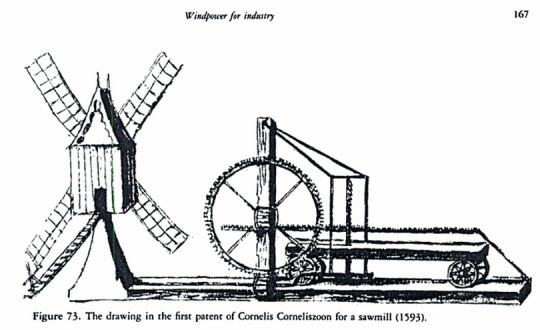
The first place to start is to shift from timber (i.e, the harvesting of raw, unprocessed logs from trees) to lumber (treating and seasoning, and sawing the logs into standardized boards, planks, beams, posts, and the like that can be used by carpenters to make furniture, housing, etc.). This requires the construction of sawmills (usually water- or wind-powered), usually downstream from the timberland so that logs can be easily floated down to the sawmill rather than going to the effort and expense of carting them overland.
The next step is to encourage the development of associated industries like furniture-making, construction...and most prized of all, ship-building. These industries continue to climb the value-added chain, because there's more money to be made from selling artisan furniture than selling raw logs and more money to be made in real estate than selling planks retail, and thus they allow you to maximize your profits from your natural resources. More importantly, if you can get into ship-building, you not only make money from selling and repairing the ships, but it's a pretty easy step from there to branch out into commerce on your own account (since you are already producing the main capital investment that seaborn commerce requires).
This is why various forms of Navigation Acts were often a key strategy of mercantilist policy during the Commercial Revolution, because if you could make sure that foreign trade was carried out by your nation's ships crewed by your sailors and your pilots and financed by your merchants, that the profits from trade would be more likely to be re-invested at home rather than exported to someone else's country.
#asoiaf#asoiaf meta#economic development#early modern economic development#mercantilism#early modern state-building#commercial revolution
42 notes
·
View notes
Text
i don’t have the time to articulate this idea in a throwaway tumblr dot com post but it’s revolting how much art has been destroyed by imperialism. obviously this comes as no great revelation, the systematic destruction and suppression of art is an integral facet of the destruction and suppression of people. specifically thinking of palestine though I always feel furious when i see the architecture of cities like Gaza leveled. the destruction of ancient buildings and cultural sites are the most obvious examples, but even the loss of modern architecture is an incredible loss. the high rise apartment blocs, shops, homes, bakeries, cafes, etc are, if they were allowed the proposer without the strangulation of imperialism, superior to anything you’ll see in a U.S. city from the perspective of providing a truly dynamic, adaptable, and cohesive habitat for people to live. I had similar thoughts seeing the destruction of cities in Ukraine, all of that Soviet era planned architecture that had such a optimistic vision for the future behind it leveled to the ground by the effects of neoliberalism. the same goes for textiles too, which i seem to talk about ad nauseam. reading all the articles on places like Hirbawi, the last kufiya factory in the west bank, which speak not only to the forced de-industrialization of palestine but also of syria, iran, iraq, etc, and the beautiful and idiosyncratic quilt patterns from different regions in palestine from that one documentary i posted earlier are all examples. nothing is new under the sun, and it’s all part of the imperial leviathan that not only destroys the potential for prosperous industry, and the industrial aspect should not be forgotten for a simplistic argument that it’s purely the burial of something nondescript and patronizing like ‘ancient culture,’ that creates fundamentally better material conditions for proletarian organization, but replaces them with parasitic import/export economies, atomized living conditions, and overly complex ‘labor saving’ technology, all tailor made to stifle class consciousness and impede cohesion of working people. the biggest crime of imperial capitalism isn’t that you’ll find young men wearing polo shirts and jeans across the world, it’s that they’re all made on the behest of (mostly) western corporations in outsourced factories, distrusted around the globe through the anarchic, wasteful, explorative, and pollutive neoliberal system when the alternatives are so much more practical and human
59 notes
·
View notes